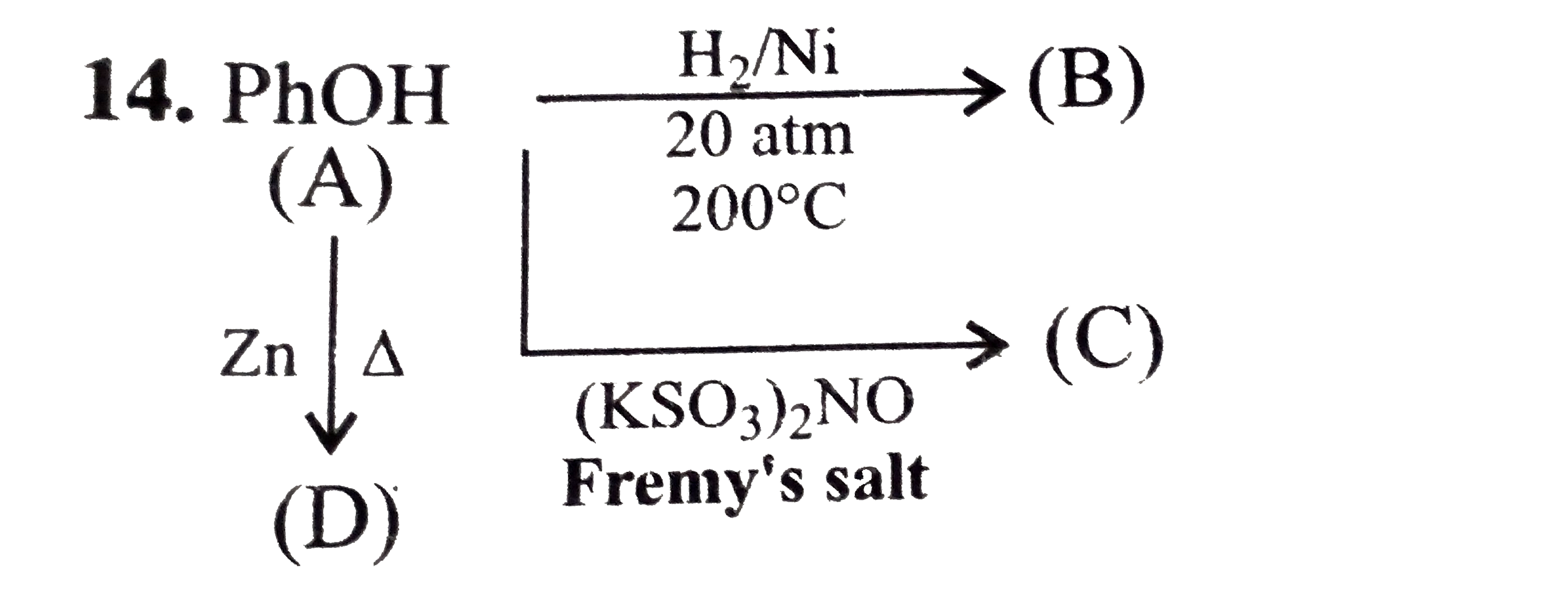
The formation of different-colour compounds (B), (C ), and (D) from (A) is called:
a.Lemieux reaction
b.Liebermann's nitroso reaction
c.Oppenaur oxidation
d.Brady's reaction
The correct Answer is:B
It is an example of Liebermann's nitroso reaction (test for nitroso group or test for phenol).

Topper's Solved these Questions
- REDUCTION AND OXIDATION REACTION OF ORGANIC COMPOUNDSBOOK - CENGAGE CHEMISTRYCHAPTER - REDUCTION AND OXIDATION REACTION OF ORGANIC COMPOUNDSEXERCISE - Exercise (Multiple Correct)
35 Videos
- REDUCTION AND OXIDATION REACTION OF ORGANIC COMPOUNDSBOOK - CENGAGE CHEMISTRYCHAPTER - REDUCTION AND OXIDATION REACTION OF ORGANIC COMPOUNDSEXERCISE - Exercise (Single Correct)
90 Videos
- REDUCTION AND OXIDATION REACTION OF ORGANIC COMPOUNDSBOOK - CENGAGE CHEMISTRYCHAPTER - REDUCTION AND OXIDATION REACTION OF ORGANIC COMPOUNDSEXERCISE - Exercise
11 Videos
- QUALITATIVE INORGANIC SALT ANALYSISBOOK - CENGAGE CHEMISTRYCHAPTER - QUALITATIVE INORGANIC SALT ANALYSISEXERCISE - Viva Voce Questions And Part-C (Analysis Of Cations)
42 Videos
- SOLID STATEBOOK - CENGAGE CHEMISTRYCHAPTER - SOLID STATEEXERCISE - Ex 1.2 (Objective)
9 Videos
Similar Questions
When calamine is heated then a product (A) is formed then find the total number of correct options for compound (A):
(a) Compound (A) is white in cold conditions.
(b) Compound (A) is yellow in hot conditions.
(c) Compound (A) is called philosopher's wool.
(d) Compound (A) when combined with CoO, then compound (B) is formed and colour of new compound (B) is green
(e) Compound (B) is called Rinmann's green
View SolutionExplain the formation of products (B), (C), and (D) in the following reaction.

View Solution
Knowledge Check

The compounds (B), (C ), (D), respectively are:ACyclohexanol, benzene, and p-quinoneBBenezene, cyclohexanol, and p-quinopneCp-Quinoue, cyclohexanol, and benezeneDCyclohexanol, p-quinone, and benzeneThe stage of gestation where the formation of different organs takes place in the embryo is called __________
AGastrulationBOrganogenesisCCleavageDBlastulationThe formation of a colloidal from suspension is
APeptisationBCondensationCSedimentationDFragmentation
Discuss the formation of coloured compounds by transition metals.
View Solution(a) On bolining a mineral (A) with Na2CO3 solution, a white precipirtate (B) is formed.
(b) The precipitate is fitered and the filtrate contains two conpounds (C) and (D). The componds (C) is removed by crystallisation and when CO2 is passed through the mother liquor left, (D) changes to (C).
( c) On strongly heating (C), two compounds (D) and (E) are formed.
(d) (E) on heating with cobalt oxide provides blue-coloured substance (F).
Identify (A) to (F) and give chemical reaction for (a) to (d).
View SolutionThe formation of an optically active compound from a chiral molecule is called:
View SolutionFormation of mRNA from DNA is called
View SolutionInner transition elements exhibit different coloured compounds on account of unfilled ........Orbitals
View Solution
